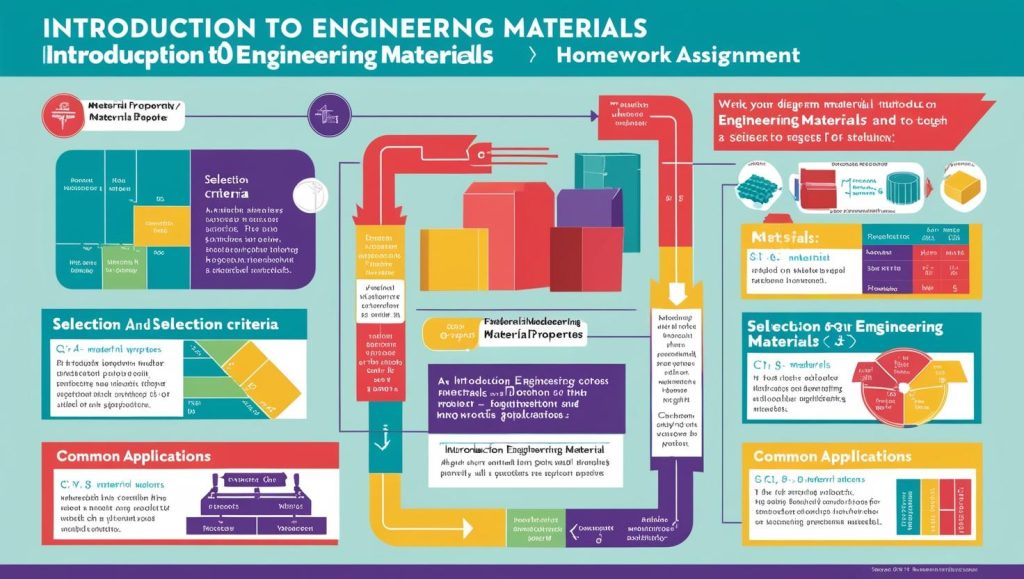Introduction
Engineering materials play a vital role in various industries, including construction, automotive, aerospace, and manufacturing. Understanding the properties, classifications, and applications of these materials is crucial for engineering students. However, completing assignments on engineering materials can be challenging due to the vast amount of information required. This is where Introduction to Engineering Materials homework help becomes invaluable.

In this guide, we will cover:
- The significance of engineering materials
- Major types of engineering materials
- Common challenges in engineering materials homework
- Tips for completing assignments effectively
- External resources for additional learning
By the end of this article, you will have a comprehensive understanding of how to excel in engineering materials homework.
Understanding Engineering Materials
What Are Engineering Materials?
Engineering materials are substances used in the design and manufacture of engineering products. They are selected based on their mechanical, thermal, electrical, and chemical properties.
Engineering materials are categorized into four major classes:
- Metals – Strong and durable materials used in construction, transportation, and tools.
- Polymers – Lightweight and corrosion-resistant materials used in packaging, insulation, and medical devices.
- Ceramics – Heat-resistant materials used in electronics, glass, and refractory applications.
- Composites – Materials that combine two or more different substances to achieve superior properties.
For a detailed classification of engineering materials, visit MIT’s Engineering Materials Guide.
Common Engineering Materials and Their Applications
1. Metals and Alloys
Metals are the most commonly used engineering materials due to their strength and electrical conductivity. Examples include:
- Steel – Used in construction and automotive industries.
- Aluminum – Found in aerospace and transportation applications.
- Copper – Commonly used in electrical wiring.
2. Polymers
Polymers are organic materials known for their flexibility and lightweight properties. Examples include:
- Polyethylene (PE) – Used in plastic bags and containers.
- Polyvinyl Chloride (PVC) – Used in piping and window frames.
- Polystyrene (PS) – Found in packaging and insulation materials.
3. Ceramics
Ceramics are non-metallic materials that exhibit high hardness and temperature resistance. Examples include:
- Silicon Carbide (SiC) – Used in high-performance braking systems.
- Alumina (Al2O3) – Found in electrical insulators and cutting tools.
- Glass – Used in optics and construction.
4. Composite Materials
Composites combine two or more materials to improve strength, weight, and durability. Examples include:
- Carbon Fiber Reinforced Polymer (CFRP) – Used in aerospace and automotive industries.
- Fiberglass – Common in boat hulls and sports equipment.
- Concrete – A combination of cement and aggregates used in construction.
For further insights, visit Material Properties Database.
Common Challenges in Engineering Materials Homework
1. Understanding Material Properties
Students often struggle with comprehending complex material properties such as tensile strength, ductility, and thermal conductivity.
2. Mathematical Calculations
Assignments may require calculations related to stress-strain analysis, Young’s modulus, and thermal expansion.
3. Material Selection for Specific Applications
Choosing the appropriate material for a given application requires an in-depth understanding of mechanical and chemical properties.
4. Researching Material Innovations
With rapid advancements in materials science, staying updated on the latest material innovations can be overwhelming.
For additional academic support, check out Khan Academy’s Materials Science Course.
Tips for Excelling in Engineering Materials Homework
1. Utilize Reliable Sources
Use trusted online resources such as:
- Materials Science and Engineering – MIT
- ASM International Materials Database
- ScienceDirect Engineering Journals
2. Understand Key Concepts
Make sure you grasp fundamental concepts such as:
- Material classification and selection
- Mechanical behavior of materials
- Phase diagrams and material processing
3. Practice Problem-Solving
Work on numerical problems related to material stress, deformation, and heat treatment processes.
4. Use Engineering Software
Familiarize yourself with software tools used in materials analysis, such as:
- ANSYS – For stress analysis and simulation.
- MATLAB – For computational modeling of material properties.
- SolidWorks – For 3D modeling of engineered components.
For software tutorials, visit Coursera’s Engineering Materials Course.
External Resources for Engineering Materials Homework Help
- NPTEL Materials Science Video Lectures – https://nptel.ac.in/courses/
- YouTube Channels on Materials Science – https://www.youtube.com/results?search_query=engineering+materials
- Engineering Stack Exchange for Q&A – https://engineering.stackexchange.com/
- Open Textbooks on Materials Science – https://openstax.org/subjects/science
Conclusion: Get the Best Introduction to Engineering Materials Homework Help
Mastering engineering materials is essential for any engineering student. Whether you’re studying metals, polymers, ceramics, or composites, having a strong foundation will help you excel in your assignments. If you find yourself struggling, consider using Introduction to Engineering Materials homework help to enhance your understanding and improve your grades.
By leveraging reliable resources, practicing problem-solving, and using engineering software, you can efficiently tackle any homework challenges related to engineering materials. Keep learning and exploring, as new material innovations continue to shape the future of engineering.


